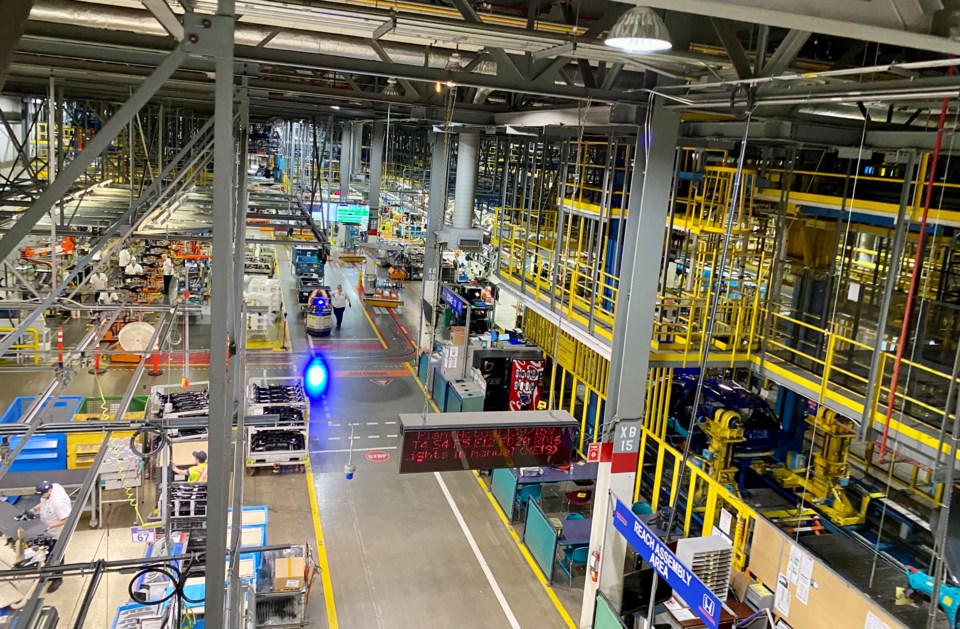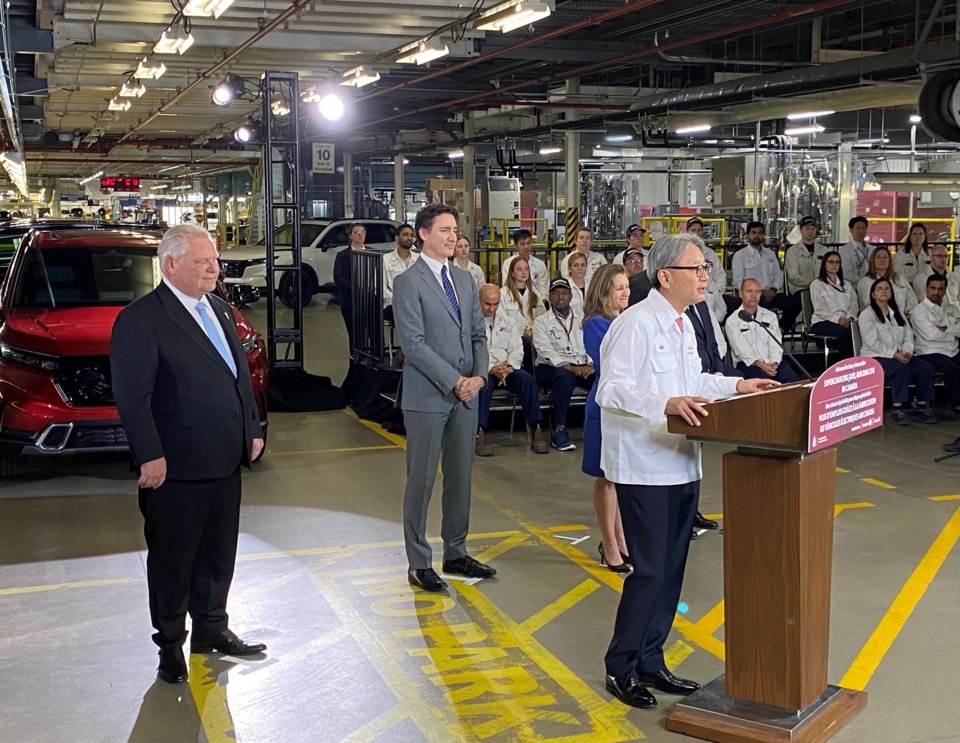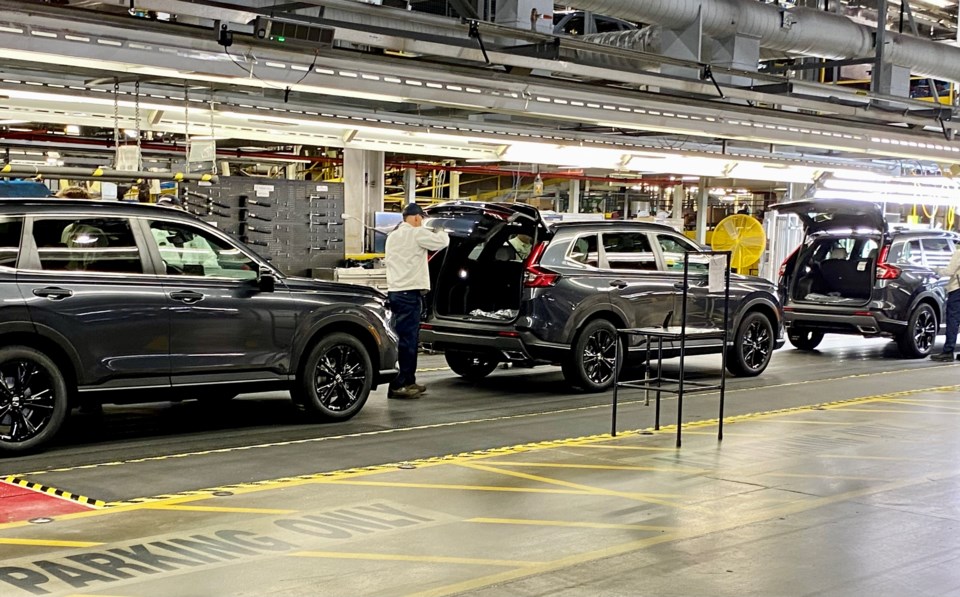The future has arrived.
Honda’s $15-billion investment in electric vehicle (EV) manufacturing in Ontario, hailed as the largest manufacturing announcement in Canadian history, with two plants in Alliston at its core, will undoubtedly have a large and rippling impact on the local economy.
Since the development of Honda Manufacturing of Canada's automotive facility in Alliston in 1986, an industry of direct suppliers and suppliers to those suppliers has grown to support the vehicle-building efforts. It has undergone ongoing growth as Honda’s only Canadian manufacturing facility where 400,000 vehicles – Civics and CR-Vs – and 190,000 engines are now built annually through the work of 4,200 employees.
Now Honda is ironing out the plans to develop four new plants from the ground up in Ontario to create an entire EV supply chain that is expected to see the production of 240,000 vehicles annually by 2028.
With Prime Minister Justin Trudeau, Ontario Premier Doug Ford and a host of federal and provincial cabinet ministers in attendance in Alliston, Honda announced on April 25 that it plans to build a new electric EV plant and a new stand-alone EV battery plant in Alliston along with two supporting plants elsewhere through partnerships.
The plans drive home efforts to reduce society’s environmental footprint. Sustainable Orillia’s Stan Mathewson points to the Canada’s mandate to have 100 per cent of new vehicles offered for sale to be zero-emission vehicles by 2035. In addition, the Canadian Net-Zero Emissions Accountability Act has set a net-zero emissions goal by 2050.

“I think it might encourage local people to adopt a little earlier,” said Mathewson, who is hopeful that others in Simcoe County may soon drive EVs, as he’s been doing since 2018. “It’s just revolutionary driving. Your cost savings, the fact you’ve got no emissions, it’s good news all around.
“It’s great to have Honda here," he added.
Honda’s investment in Alliston goes a long way to not just meeting those environmental goals, but also ensuring the future of the area’s manufacturing sector and building upon it as the still somewhat nascent EV industry develops further in central Ontario.
Honda’s Ontario investments, particularly with its Alliston presence, adds up to employment, business and economic opportunities.
Steve Loftus points out that Ontario, particularly the southern portion of the province, has one of the largest concentrations of auto manufacturing in the world. As a result, he says, all the infrastructure that’s needed to go to the next step – which is EV production – is here.
“They all exist in Ontario … people in Ontario don’t tap themselves on the back enough to say: ‘We are at the forefront of this technology,’” Loftus said. “We’re the guys that are in the top two or three concentrations or clusters in the world in auto and EV battery manufacturing.”
Loftus is a founder of Innovative Automation, which began in Barrie in 1989. He has been serving as the company’s CEO since 2021. The organization has since developed into a group of companies.
The core business is custom machine building, which has grown to employ 200 people in Barrie, supplying manufacturers, including Tier 1 suppliers to Honda. Its MecSmart Systems in Newmarket deals primarily with metal assembly and employs 30 people. Robotape is a proprietary product that employs 15 people in Barrie and Newmarket, and also has global partners in Japan, Germany and England.
Loftus says he expects Honda will require a variety of technology, some of it newly developed, as the Alliston facility looks to be in full EV production by 2028. There is also the daily need for the material used in production, such as steel or aluminum or material required for the battery packs.
“Is there going to be work for other people? Definitely. Because there’s going to be someone building this technology,” said Loftus, who sees potential for opportunity for his Robotape business in Honda’s battery development, as well as components as the Japanese automaker looks to source products, material and machinery.
Systems design engineer Sheri Williams, who is the industry X lead at Accenture Canada where she focuses on operations of digital manufacturing facilities, says Canada has all of the pieces necessary to create a strong and stable EV supply chain, including the mining of some of the components.
Accenture combines digital capabilities and deep engineering, operations and infrastructure expertise to deliver artificial intelligence and automation solutions for the manufacturing industry.
“If you look at Canada as a geography, we actually can manage that entire end-to-end supply chain and that’s why you’re seeing the investments,” she said. “If we can get the scale … I think the world will look at Ontario as a very safe place … to do this kind of work with sustainable power which is going to be really important.
“I think there’s a lot of innovation that’s going to happen around it … (and) I think it has a huge opportunity to accelerate our economy," Williams added.
And that further establishes the area as a major automotive manufacturing hub, says Simcoe County Warden Basil Clarke. More than 10 per cent of the county’s labour force works in manufacturing – one-third of which is related to the automotive sector.
“With this being the single largest investment by an international auto manufacturer in the history of Canada, the impact on our region will be felt for decades to come,” Clarke said. “This is great news for Canada, Ontario, Simcoe County and the Town of New Tecumseth.
"With this investment, Honda is not only supporting additional jobs and growth in our region, but also helping build up and support healthy, vibrant communities," he added.

Honda’s “EV value chain” is to also include the creation of a cathode active material and precursor (CAM/pCAM) processing plant and a separator plant through two joint venture partnerships.
Korean battery materials company POSCO Future M Co., Ltd and Japanese chemical company Asahi Kasei Corporation are each to have Ontario facilities as part of that overall investment, according to Honda.
On Tuesday, three weeks after the announcement in Alliston, Trudeau and Ford gathered again, this time in Port Colborne, celebrating Asahi Kasei Corporation’s announcement of its plans to build a $1.6-billion EV battery separator plant there. Construction is slated for this year with the goal of being commercially operational in 2027.
The joint venture company, between Honda and Asahi Kasei Corporation, is to concentrate on the production of battery separators for automotive batteries in Canada.
The separator is a critical component of lithium-ion batteries. It is a porous membrane that prevents electrical short circuits by blocking contact between cathode and anode materials while allowing lithium ions to permeate through it.
In a joint news release about the second collaboration, POSCO Future M indicated a “basic agreement” developed from a discussion of a comprehensive partnership toward the realization of carbon neutrality which began in April 2023 as the two companies considered the possibility of co-operating in the procurement of key battery materials.
Honda earlier indicated many details of those plans is still being worked out and final agreements on those partnerships are expected to be formalized this year.
However, just where the POSCO facility will be located hasn’t yet been revealed.
“The purpose of this basic agreement is to steadily execute respective electrification strategies by ensuring steady procurement of high-performance batteries in the North American electrification market, where mid- to long-term growth is expected,” POSCO stated in a release.
The goal is to establish of a joint venture company which will supply cathode materials for EV batteries for the North American market.
As Honda gets all of the EV manufacturing pieces in place, it indicates it’s still all-systems-go on the work currently going on.
Honda spokesperson Ken Chui says the gas and hybrid vehicle production in Alliston will continue during the transition to EVs, which is expected to begin in 2028.
“Nothing changes on Line 1 and Line 2 for the foreseeable future – we will continue to build gas and hybrid cars as EVs begin production at its new plant,” Chui responded in an email. “The transition to hybrids are an integral part of Honda’s electrification strategy.
"The new Civic Hybrid begins production this year in Alliston. The new plant is for pure EVs. Different plants for different cars.”
Honda’s plans, which will continue to unfold as more details become clear, is significant in its full-picture design of EV development and construction.
Brendan Sweeney, managing director of Trillium Network for Advanced Manufacturing and Western University Social Science Centre, marvelled at the enormity of Honda’s announcement as he listened to the details in Alliston last month.
He also pointed to its plan to finance it with the help of the federal government which has created a 10 per cent EV supply chain investment tax credit to attract private investment in EV assembly, battery production and cathode active material production.
“They’ve managed to line up all three of the highest-value components of the EV supply chain: the assembly, the battery cell manufacturing and what we’ll hear more about down the road: the cathode active material manufacturing, the CAM manufacturing – one of the most important parts of the actual battery cell," Sweeney said. "I think they’ve managed to do it creatively with the tax credit, with some other incentives.
“This is a real vote in confidence in Simcoe County, the people that they have here, the way we do business in Ontario and in Canada.”



